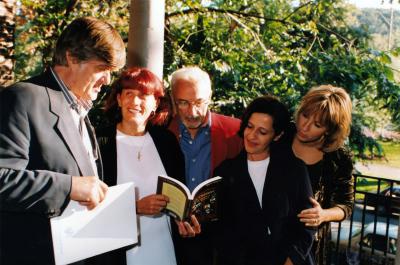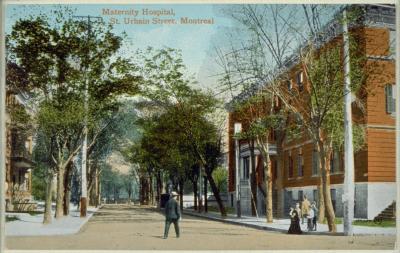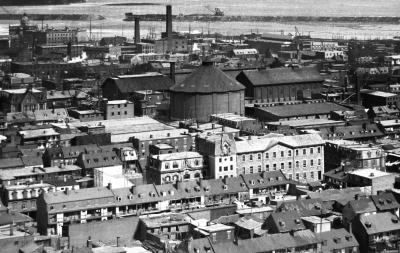Institut Nazareth was created in 1861 to house and educate people who were blind. It was the first institution of its kind in Canada, and left a profound mark on the city of Montréal.
Institut Nazareth 1920
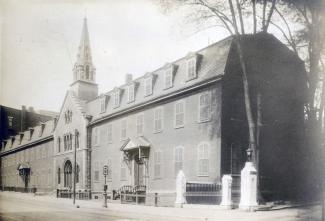
Until the mid-1800s, blindness and poverty formed a vicious circle. Being considered unfit for work condemned people who were blind to poverty, while visual impairments often resulted from the very poverty people lived in. Many of the leading causes of blindness—poor hygiene, malnutrition, and workplace accidents—were primarily the lot of the working classes. People who were blind and had families that could not look after them often tried to survive by begging in the city streets or working as buskers, fortune tellers, or peddlers. As a last resort, they could hope to find a meal and a bed at shelters such as the Montréal General Hospital or the Asile de la Providence.
Montréal’s first institution for the blind was the initiative of Father Benjamin-Victor Rousselot. A French priest with eyesight problems of his own, he took inspiration from the Institution des aveugles in Paris, and in 1858 he founded a first asylum in Montréal, occupying a part of Hospice Saint-Joseph. It served not only people who were blind but also the destitute of the Saint-Antoine district. Three years later, Rousselot asked the Grey Nuns to open a new establishment on a swath of land on rue Sainte-Catherine, between Saint-Urbain and Jeanne-Mance. The institution known as “Asile Nazareth” was born.
A pioneering institution
Atelier Nazareth
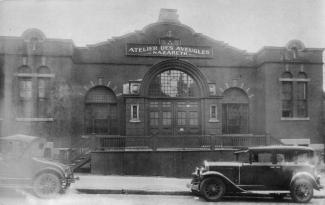
In March 1862, Asile Nazareth welcomed its first blind resident. Caring for and educating people who were blind soon became the establishment’s primary vocation. In 1869, a new building with a chapel for the blind was added. The design was by Victor Bourgeau, one of the architects of the Notre-Dame Basilica, and the chapel’s interior decoration was the work of the artist Napoléon Bourassa. Behind the chapel there was a greenspace with flowerbeds, a vegetable garden, and fruit trees.
In its first decade, the Asile Nazareth took in three or four new residents per year. But starting in the 1870s, admissions doubled. By the early 1900s the Asylum was accepting around twelve new pupils every year.
In these early years, reading and writing systems for the blind in Canada were in their infancy. Initially, the nuns focused on teaching their students to work with their hands. But Institut Nazareth then pioneered literacy education for the blind, and was among the first schools in North America to teach braille.
It took nearly a century for the tactile writing system created by Louis Braille in the late 1820s to become standard in the West. When Asile Nazareth opened its doors, multiple writing systems were competing for dominance, especially in North America. Even once the sisters of the Asile Nazareth settled on braille, the problem of finding books remained. The few braille books available were printed in Europe, and high shipping costs meant very few crossed over to North America. At Asile Nazareth, teachers used oral instruction to compensate for this scarcity of books, and began teaching their students braille as early as 1865.
Institut Nazareth also had workshops for vocational training and a music department. In fact, musical education was a focus: they trained a large number of musicians, many of whom went on to careers as church organists and piano tuners.
Moves and changes
Institut Louis-Braille
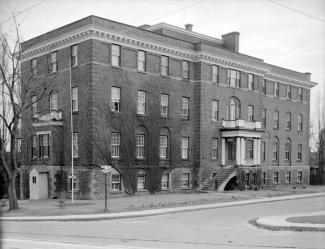
In the early 1900s, the institute’s student body swelled, reaching a peak of around one hundred in the early 1930s. Students were still drawn largely from the working classes, and their number had outgrown the institute’s capacity. Residents were crammed into overcrowded, poorly ventilated dormitories. The neighbourhood was changing too: the city had since engulfed what had been a bucolic stretch of land on the city’s outskirts when the school opened.
In 1932, the institute moved into a brand new building better suited to its needs at 4565 chemin Queen-Mary. The spacious new building had modern conveniences like showers and soundproofed, well-ventilated music practice rooms. With this move, a new era began for the Nazareth community. From that point on, it would continue to grow substantially.
The 1930s saw the emergence of new associations serving the visually impaired. Many of these were created by former Nazareth residents. New services meant competition, and Institut Nazareth left certain services to others. As time passed, the institute focused on educating school-age students. In the early 1940s, it began operating as a specialized school for children and adults under twenty-five who were blind. And in 1940, the institute again relocated, this time to a building on Côte-Saint-Michel (now boulevard Crémazie Est).
Though it had been co-educational from its earliest beginnings, in 1953, Institut Nazareth became a girl’s school. Boys were educated at the brand new Institut Louis-Braille, operated by the Clerics of Saint-Viateur, located on rue Claremont in Westmount until it moved to rue Beauregard in Longueuil in 1960.
Government reforms, a new mandate
Institut Nazareth - enseignement
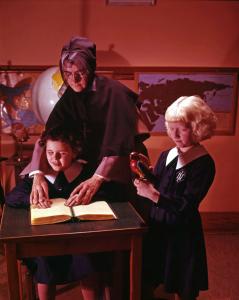
With the expansion of Québec’s welfare state in the 1960s and 1970s, the government took over health care and services for people with disabilities. In the early 1960s, special schools opened with classes for students who were partially sighted. And in 1974, Québec’s education ministry took charge of education in institutions managed by the social affairs ministry; this included students who were blind or partially sighted and being educated at Institut Nazareth and Institut Louis-Braille.
Québec government policies transformed the two main institutions for people who were blind: in 1975 Institut Nazareth and Institut Louis-Braille merged into a single public institution, Institut Nazareth et Louis-Braille. The Grey Nuns religious community took over the building occupied by Institut Nazareth on boulevard Crémazie. And the students both organizations came together on a single campus, the former Institut Louis-Braille in Longueuil.
Further change came in 1979 when the Québec government decentralized education for children who were blind or partially sighted. Those in the western part of Québec would now be served by the Chambly school board. This reform ended Institut Nazareth et Louis-Braille’s mandate as an educational institution.
Now located at 1111 rue Saint-Charles in Longueuil, Institut Nazareth et Louis-Braille is a rehabilitation centre and part of the CISSS de la Montérégie-Centre (an integrated health and social services centre). The institute provides a range of rehabilitation services to people who are blind or partially sighted living in greater Montréal and the Montérégie and Laval regions.
COMMEND, Susanne. Les Instituts Nazareth et Louis-Braille, 1861-2001 : Une histoire de cœur et de vision, Québec, Septentrion, 2001, 326 p.
PATRIMOINE IMMATÉRIEL RELIGIEUX DU QUÉBEC. « L’éducation aux aveugles à l’Institut Nazareth », [En ligne], Récit de pratique culturelle.
http://www.ipir.ulaval.ca/fiche.php?id=378
TRUDEAU, Nicole. « Institut Nazareth », [En ligne], Encyclopédie canadienne, 16 décembre 2013.
https://www.thecanadianencyclopedia.ca/fr/article/institut-nazareth

